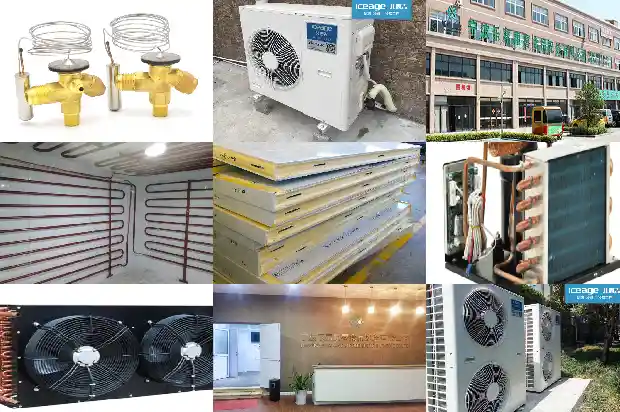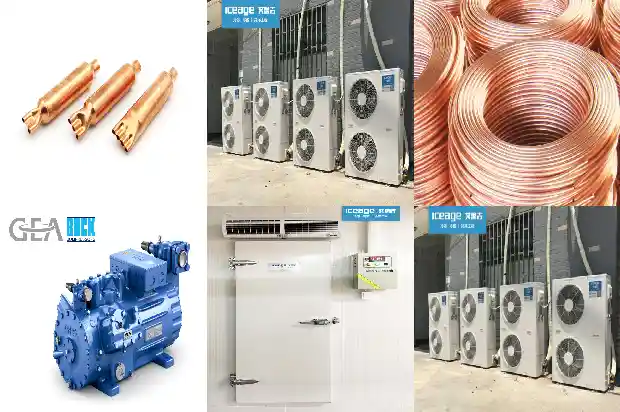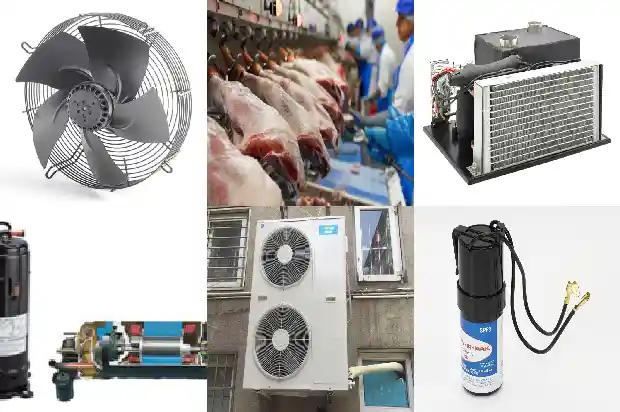Popularize Refrigeration Knowledge You've Never Noticed, Which Is Actually Very Crucial
2025-02-28
- Why Do We Need to Control the Impurity and Moisture Contents in the Compressor and Air - Conditioning System?
When impurities enter the friction surfaces of the moving parts inside the compressor pump body, it will cause abnormal scratching and wear. When impurities enter the solenoid valves, expansion valves, control valves, capillary tubes, and stop valves in the air - conditioning system, they will block the valve holes or make the valves fail to close tightly.
The moisture in the compressor and air - conditioning system mainly has the following adverse effects:
The capillary tube and expansion valve will experience ice blockage, and the cooling tubes of the evaporator will also freeze;
The metal materials will be corroded, and deposits will be generated;
The valve core will be corroded, and the valve will not close tightly;
The "copper plating" phenomenon will occur on the surface of the compressor pump body parts;
It will accelerate the deterioration of materials such as insulation materials, refrigerants, and refrigeration oils.
Moisture exceeds the standard. - What Impact Will Low Voltage Have on the Air - Conditioning System?
If the voltage is too low, far below the specified operating voltage range of the compressor, since the locked - rotor current value is likely not to reach the operating current specification of the protector, the protector will not be able to act in a timely manner, causing the compressor motor to overheat and even burn out. - What Are the Functions and Principles of the Compressor Protector?
The function of the compressor protector is mainly to prevent accidents such as motor burnout when the compressor is in an abnormal situation.
The main principle: It relies on the combined action of the heating wire inside the protector and the internal resistance of the bimetallic strip, which generates heat through the current and the external heat conduction, to make the bimetallic strip act, thus cutting off the circuit and protecting the compressor from damage. - How to Make Basic Judgments and Handling After the Compressor Fails?
Unable to start, with no suction and exhaust pressure: First, detect the compressor wiring, pipeline connection, and basic items such as the impedance of the main and auxiliary coils and the insulation withstand voltage of the compressor. If everything is normal, it is recommended to remove the compressor and conduct an idle rotation test to check if there is suction and exhaust.
The suction and exhaust method is: When the compressor is running, press your finger on the exhaust port for a few seconds, and then release it to observe if there is gas ejection. It is normal to have a small amount of oil ejected. If there is suction and exhaust, and the exhaust pressure is relatively high, it means the compressor can work normally; otherwise, the compressor is abnormal. - Why Is It Necessary to Prohibit the Liquid Refrigerant from Flowing Back into the Compressor Suction Chamber?
If the liquid refrigerant directly enters the compressor suction chamber, during the rotation of the crankshaft, the volume of the compressor becomes smaller and smaller, and the pressure rises sharply, resulting in abnormal stress on the pump body parts and valve plates, or even damage. Liquid slugging will also cause abnormal vibration and noise of the compressor.
In addition, after the liquid refrigerant enters the cylinder, it will "wash away" the lubricating oil on the surfaces of parts such as the piston and blades, resulting in a situation equivalent to "running without oil," causing abnormal wear and even compressor seizing.
Abnormal wear - Why Shouldn't the Refrigerant Recovery Time of the Air - Conditioner Be Too Long?
The refrigerant recovery operation time of the air - conditioner should not be too long. Because after a long refrigerant recovery time, due to the extremely thin refrigerant gas inhaled, the exhaust temperature will be very high, causing the temperature of the compressor pump body components to rise rapidly. Excessively high temperatures will cause the expansion degrees of various parts to differ too much, resulting in the clearance between some parts becoming smaller or even disappearing, ultimately causing abnormal scratching or wear. - What Are the Impacts of Incorrect Wiring of the Compressor? Why Can't the Protector Provide Protection?
Incorrect wiring of the compressor will make it unable to work normally. According to different incorrect wiring methods, phenomena such as locked - rotor, reverse rotation, and stopping after starting may occur, and it is very likely to cause the direct burnout of the compressor motor.
Since the compressor protector is selected according to the working characteristics of the protector under abnormal working conditions when the compressor is correctly wired, it cannot ensure the protection of the compressor when the wiring is incorrect. Under the condition of incorrect wiring, it is difficult to protect the motor through the protector. - For the Same System, Is It Necessary to Adjust the System When Replacing Compressors from Different Manufacturers?
Since the performance characteristics of compressors produced by different companies are different, for a specific compressor, its best performance will only be demonstrated under specific conditions such as refrigerant flow rate, suction and exhaust pressure, and temperature.
Therefore, when using different compressors in the same air - conditioning system, it is best to adjust the system separately to ensure that the used compressor works normally under appropriate refrigerant flow rate, suction and exhaust pressure, and temperature conditions. In this way, the service life of the compressor can be effectively extended and the best use effect can be achieved. - Why Is There a Requirement for the Temperature of the Compressor Motor Coil During Operation?
It is determined by the insulation class (Insulation classes: A (105°C), E (120°C), B (130°C), F (155 °C), H (175°C)) and heat resistance characteristics of the insulation materials used in the compressor motor. For the motor enameled wire, too high a temperature will lead to a reduction in the film thickness, a decrease in abrasion resistance, easy peeling, a decrease in the insulation breakdown voltage and insulation impedance, etc.
, thus greatly reducing the service life.
In addition, too high a motor temperature can cause excessive dissolution of polymers in the insulation material. These substances will precipitate and accumulate somewhere in the system or at the compressor exhaust port, etc., thus affecting the performance of the compressor and the system. Moreover, too high a coil temperature will reduce the efficiency of the compressor motor. - Why Should the Compressor Be Stopped for at Least 3 Minutes After Shutdown Before It Can Be Started Again?
When the compressor starts, a large amount of refrigeration oil will enter the air - conditioner system along with the refrigerant circulation. If there is not enough running time, the refrigeration oil will not be able to return to the compressor cavity in time. Frequently stopping the compressor soon after starting will lead to a low oil level inside the compressor, which is likely to cause poor lubrication of the mechanical moving parts of the compressor.
In addition, the shutdown time of more than 3 minutes is mainly to give the system enough time for pressure balance. Otherwise, due to the existence of high and low pressures, the compressor will not be able to start normally. - Why Can't the Compressor Operate Under "Vacuum Conditions"?
The so - called "vacuum conditions" are not an absolute vacuum state but a state of extremely low air pressure. Gas molecules will ionize under extremely low pressure.
According to the actual experimental results, the breakdown voltage of the compressor terminals is the lowest when the internal pressure of the compressor is around 3.5mmHg. Breakdown and internal carbon deposition are likely to occur when the power is on, damaging the insulation of the sealed terminal. In severe cases, the sealed terminal of the compressor may burn out and fly out during operation. Therefore, it is necessary to avoid energizing the compressor in a vacuum state.
Related Articles
- Analysis of Common Auxiliary Components in the Refrigeration System
- Does the Refrigeration System Definitely Need to Be Evacuated? What Will Happen If It Isn't?
- Common Faults in Refrigeration Systems and Handling Methods
- Why Should Refrigeration Shut - off Valves Have "Low - Inlet and High - Outlet" Design?
- Four Requirements for Refrigeration Systems Adopting Two - stage Compression Refrigeration Systems
- Screw Compressor Units: Principles, Design and Selection - Essential Guide for Refrigeration Beginners
- Don't Overlook: The Impact of Capillary Tube Length on Refrigeration System Parameters
- Refrigeration Repair Techniques: A Must - Know - "Sub - cooling" and "Super - heating"
- What Impact Does Pressure Have on the Refrigeration System?
- Advanced Guide! Design and Installation of Refrigeration System Pipelines
- Defrosting Heating Tubes in Refrigeration Devices
- Refrigeration Components of Refrigeration
- Refrigeration System: Copper Pipe Welding and Flushing Operations
- Have You Encountered the Three Common Problems of Refrigeration Compressors?
- How to Calculate Refrigeration Load? And What Are the Issues?
- What to Do if the Compressor of a Frozen and Refrigerated Display Cabinet Runs but the Refrigeration Effect Is Poor?
- Instructions for Welding and Drainage in the Installation of Refrigeration Equipment Pipelines
- Common Pressure Valves and Protection Devices in Refrigeration Units
